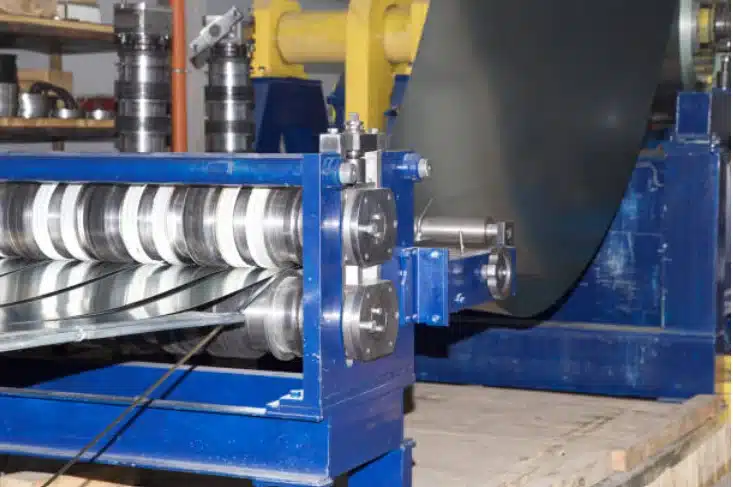Precision in Motion: How Slitting Machines Drive B2B Manufacturing Efficiency

In busy factories that handle large volumes of material-whether film, foil, non-wovens, or paper-slitting machines are quiet heroes on the production floor. For B2B brands in packaging, converting, and printing, the ability to slice giant rolls into smaller, usable widths keeps lines moving, products customized, and deliveries on time.
Today’s models come loaded with servo-driven automation, real-time tension sensors, and smart edge-guiding. These features trim scrap, boost speed, and ensure every roll meets the strict quality standards customers demand.
KTET GROUP provides a comprehensive portfolio of slitting machines engineered for high-performance material processing. By partnering with KTET GROUP, producers gain tools that enhance precision and efficiency across a wide range of applications.
Understanding the Basics: What Is a Slitting Machine?
A slitting machine unwinds a large master roll, cuts it into narrower strips, and rewinds those strips into smaller rolls ready for the next step in production or shipping. slitting, or roll slitting, turns bulk material into convenient widths that line operators can handle easily, whether the end goal is packaging, printing, or further converting.
Manufacturers typically rely on two main slitting methods to cut rolls of material to exact width:
- Razor slitting uses sharp fixed blades for very thin webs such as plastic film.
- Shear slitting employs upper and lower rotating knives, ideal for heavier, multi-layer substrates.
Such machines show up in nearly every production line that works with flexible media:
- Flexible packaging.
- Labeling and pressure-sensitive tape.
- Battery and capacitor production.
- Printed film and paper runs.
- Non-woven fabric.
For many B2B plants, slitting represents the final step before rolls leave the floor or enter downstream processing.
Features B2B Buyers Consider Most
When selecting a slitting line, converters weigh many performance and ergonomic factors. Three features stand out as especially crucial.
Web Tension Control
Uniform tension at the unwind and rewind stations keeps cuts straight and free of wrinkles. Modern lines rely on load cells paired with servo motors that adjust tension in real time.
Edge Positioning and Tracking
Integrated sensors and actuators monitor the web edges and correct drift on-the-fly, giving operators clean slits with less manual checking.
Knife Positioning Systems
Some modern machines move the slitting knives into place by themselves. This quick adjustment cuts down on changeover time and boosts productivity, especially in factories that often switch materials.
Slit Width Adjustment
Being able to change slit widths fast is essential when a shop runs many different products. Good equipment offers both fine adjustments and a way to set new widths in seconds.
Rewind Shaft Options
Depending on the job, you might need duplex turret rewinders, differential shafts, or simple friction shafts. The choice will change how tension builds as the roll is formed, which in turn affects finished-product quality.
KTETGROUP builds slitting lines with these features included, giving users precise control and easy setup for demanding work environments.
Industrial Applications Across Sectors
Slitting machines show up in nearly every business-to-business market. Here are some ways different industries gain from high-performance slitting gear:
Packaging Industry
Films, laminates, and barrier materials are cut to the right width before going into pouch-making or shrink-wrap lines. Steady, uniform rolls help seals stick and labels read clearly later on.
Electronics Manufacturing
Conductive films, battery separators, and similar specialty materials can easily tear or generate static. To keep them intact during assembly, precision slitting is non-negotiable.
Medical and Hygiene Products
Non-woven webs for diapers, masks, and surgical gowns are produced in massive batches. Every cut must be clean and true, or the entire line fails quality tests.
Label and Adhesive Production
Stickers, tape, and thermal labels live or die by their edge quality. A crooked slice can ruin adhesion, branding, and customer trust.
Printing and Paper Converting
Rolls of printed paper feed into books, notepads, packaging inserts, and countless other items. For heavy or laminated stock, shear slitting is often the best choice.
KTETGROUP offers slitting machines tailored to each sector, helping factories boost material flow and overall output.
Best Practices for Selecting the Right Slitting Machine
Before spending money on a slitting line, buyers should answer a few straightforward questions to ensure the equipment meets both today’s workload and tomorrow’s growth:
- What materials are being processed? Knife style, tension level, and cutting speed vary widely with each substrate.
- What is your roll width and diameter? Your master roll should fit without expensive upgrades.
- How often do you change product mix? For many SKUs, choose a faster changeover design.
- Is automation a must? Touchscreens, remote diagnostics, and auto-knife setup cut training time and errors.
- What downstream machines will you use? Make sure the slitter links smoothly with your laminator, bag maker, or printer.
Working with KTETGROUP means you get expert advice and solutions, whether you run low-volume specialty jobs or high-speed continuous lines.
The Future of Slitting Machines in Smart Manufacturing
With Industry 4.0 gaining ground, today’s slitters are becoming smart, data-connected tools inside the factory.
Key Trends to Watch:
- IoT diagnostics: Monitor knife life, bearing temps, and web tension in real time.
- Cloud analytics: Review production trends from anywhere to spot delays and gains.
- AI slitting: Machine-learning models fine-tune knife angles and speeds based on material and history.
- Eco-efficiency: Servo motors, energy-saving drives, and regenerative braking cut power use from the floor up.
Forward-thinking businesses are already adding these features, freeing resources that they can use to slash delays, gain production wiggle room, and boost their green numbers across the board.To see models, specs, and extras, browse KTETGROUP’s https://www.ketegroup.com/fr/product-category/slitting-machine/
Conclusion
A slitting machine looks like one tiny cog in a huge line, yet the way it trims, tracks, and scores material can swing efficiency, waste, and finish quality by wide margins. For manufacturers, converters, and suppliers, spending on a sturdy, well-designed slitter goes far beyond adding volume-it buys accuracy, flexibility, and reliability that last for years.
With years of hands-on work in converting tech, KTETGROUP has built a line of smart slitters that meet the tough routines of today’s business customers.

Why Smart Startups Choose Custom AI Business Solutions Today

How to Optimize Business Operations with Vending Machines in Australia

How a portable office for sale can streamline on-site operations and boost productivity

Onsite Tire Change in Ottawa : Safe Fast & Professional Tire Services

Accelerating drug discovery through the DEL-ML-CS approach

Top Reasons Law Firms Are Replacing Call Centers With TeleWizard

5 Common Multi-Cloud Networking Mistakes & Fixes

Eye-Catching Composition Techniques Using Action Camera Wide-Angle Lenses








